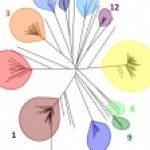Link to Pubmed [PMID] – 25595446
Eukaryotic Cell 2015 Mar;14(3):311-22
Loss of heterozygosity (LOH) plays important roles in genome dynamics, notably, during tumorigenesis. In the fungal pathogen Candida albicans, LOH contributes to the acquisition of antifungal resistance. In order to investigate the mechanisms that regulate LOH in C. albicans, we have established a novel method combining an artificial heterozygous locus harboring the blue fluorescent protein and green fluorescent protein markers and flow cytometry to detect LOH events at the single-cell level. Using this fluorescence-based method, we have confirmed that elevated temperature, treatment with methyl methanesulfonate, and inactivation of the Mec1 DNA damage checkpoint kinase triggered an increase in the frequency of LOH. Taking advantage of this system, we have searched for C. albicans genes whose overexpression triggered an increase in LOH and identified four candidates, some of which are known regulators of genome dynamics with human homologues contributing to cancer progression. Hence, the approach presented here will allow the implementation of new screens to identify genes that are important for genome stability in C. albicans and more generally in eukaryotic cells.








